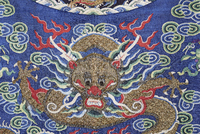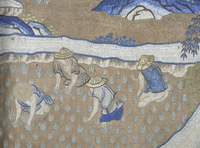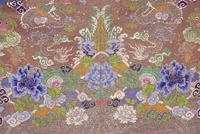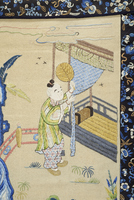-

Full-length garment, front overlap closing to right, fastened with five loop and knotted-cord toggle buttons, tapered sleeves ending with flared cuffs, front and back vents
-

Calf-length garment, front overlap closing at right, fastened with three loop and (missing) toggle buttons, long sleeves, collar, side vents
-

Calf-length garment, front overlap closing at right, fastened with three loop and (missing) toggle buttons, long sleeves, collar, side vents
-

Calf-length garment, front overlap closing at right, fastened with three loop and (missing) toggle buttons, long sleeves, collar, side vents
-

Calf-length garment, center front opening, fastening with one loop and gilt-metal ball toggle button and a pair of ties, side and back vents
-

Full-length garment, front overlap closing to right, fastened with five loop and knotted-cord toggle buttons, tapered sleeves ending with flared cuffs, front and back vents.
-

Full-length garment, front overlap closing to right, fastened with five loop and knotted-cord toggle buttons, tapered sleeves ending with flared cuffs, front and back vents.
-

Oversized calf-length garment, front overlap closing to right, fastened with one loop and knotted-cord toggle button, a pair of ties, long side sleeves, side vents
-

-

-

-

-

Calf-length garment, front overlap closing to right, fastend with six loop and five gilt-metal ball and one knotted‐cord toggle buttons, long, wide sleeves, collar, side vents
-

Calf-length garment, front overlap closing to right, fastened with six loop an knotted‐cord toggle buttons, wide sleeves ending with optional turned back cuffs, collar, side vents
-

w/tassels
-

-

silk tassels
-

embroidery on red satin; figures in garden
-

crane in garden; embroidery on black
-

crane in garden; embroidery on black
-

crane in garden; embroidery on black
-

<p>In Confucianism, the code of moral conduct associated with the teachings of the Chinese philosopher Confucius, or Kongzi <span lang="ZH-TW" style="font-family:"PMingLiU",serif">孔子</span>, 551-479 B.C.E., filial piety is the most important principle to regulate human relationships and maintain social order. Filial piety is defined as the humane and ethical behavior that should guide interactions among individuals, families, and members of every level of government, the healthy balance of which will result in a peaceful and harmonious society.</p>
<p>The <i>Classic of Filial Piety</i> (<i>Xiaojing</i> <span style="font-family:SimSun">孝經</span>), an anonymous text produced between the fourth and third century B.C.E., described proper behavior and became as influential in East Asia as sacred religious texts. The concept of filial piety was also promoted beyond Confucian doctrine: narratives of exemplary Buddhists touted their devotion to treating others with love and respect. Chinese stories about benevolence and loyalty express the deep-rooted conviction that a benevolent superior, whether ruler, official, or father, who does not abuse his power, but respects those in his care, will, in turn, enjoy the respect and obedience of his subjects and descendants.</p>
<p>During the Yuan dynasty (1260-1368), Guo Jujing (<span lang="ZH-TW" style="font-family:SimSun">郭居</span><span style="font-family:SimSun">敬</span>) composed an illustrated manual featuring stories from <i>Twenty-Four Paragons of Filial Piety</i> (<i>Ershisi Xiao</i><span lang="ZH-TW" style="font-family:SimSun">二十四孝</span>), which became the most prominent text used for teaching this concept. Designed to motivate the reader to emulate the behavior of virtuous individuals, the stories concentrate on the loyalty, obedience, and respect shown by those in the position of dependent.</p>
<p>In addition to the moral standards propagated in printed filial piety manuals, honor and respect for elders was often expressed at celebratory events, such as significant birthdays. The congratulatory paintings, wall hangings, and cards, and the festive attire worn on such occasions are often decorated with auspicious characters and images.</p>
<p>The selection of embroidered textiles depicting stories or scenes from the <i>Twenty-Four Paragons</i> included in this installation reflect the proliferation of the topic in Chinese literature and material culture. They are also included here as examples for various stitches of the exquisite embroideries in the Warner collection.</p>
-

<p>In Confucianism, the code of moral conduct associated with the teachings of the Chinese philosopher Confucius, or Kongzi 孔子, 551-479 B.C.E., filial piety is the most important principle to regulate human relationships and maintain social order. Filial piety is defined as the humane and ethical behavior that should guide interactions among individuals, families, and members of every level of government, the healthy balance of which will result in a peaceful and harmonious society.</p>
<p>The <i>Classic of Filial Piety</i> (<i>Xiaojing</i> 孝經), an anonymous text produced between the fourth and third century B.C.E., described proper behavior and became as influential in East Asia as sacred religious texts. The concept of filial piety was also promoted beyond Confucian doctrine: narratives of exemplary Buddhists touted their devotion to treating others with love and respect. Chinese stories about benevolence and loyalty express the deep-rooted conviction that a benevolent superior, whether ruler, official, or father, who does not abuse his power, but respects those in his care, will, in turn, enjoy the respect and obedience of his subjects and descendants.</p>
<p>During the Yuan dynasty (1260-1368), Guo Jujing (郭居敬) composed an illustrated manual featuring stories from <i>Twenty-Four Paragons of Filial Piety</i> (<i>Ershisi Xiao</i>二十四孝), which became the most prominent text used for teaching this concept. Designed to motivate the reader to emulate the behavior of virtuous individuals, the stories concentrate on the loyalty, obedience, and respect shown by those in the position of dependent.</p>
<p>In addition to the moral standards propagated in printed filial piety manuals, honor and respect for elders was often expressed at celebratory events, such as significant birthdays. The congratulatory paintings, wall hangings, and cards, and the festive attire worn on such occasions are often decorated with auspicious characters and images.</p>
<p>The selection of embroidered textiles depicting stories or scenes from the <i>Twenty-Four Paragons</i> included in this installation reflect the proliferation of the topic in Chinese literature and material culture. They are also included here as examples for various stitches of the exquisite embroideries in the Warner collection.</p>
-

<p>In Confucianism, the code of moral conduct associated with the teachings of the Chinese philosopher Confucius, or Kongzi 孔子, 551-479 B.C.E., filial piety is the most important principle to regulate human relationships and maintain social order. Filial piety is defined as the humane and ethical behavior that should guide interactions among individuals, families, and members of every level of government, the healthy balance of which will result in a peaceful and harmonious society.</p>
<p>The <i>Classic of Filial Piety</i> (<i>Xiaojing</i> 孝經), an anonymous text produced between the fourth and third century B.C.E., described proper behavior and became as influential in East Asia as sacred religious texts. The concept of filial piety was also promoted beyond Confucian doctrine: narratives of exemplary Buddhists touted their devotion to treating others with love and respect. Chinese stories about benevolence and loyalty express the deep-rooted conviction that a benevolent superior, whether ruler, official, or father, who does not abuse his power, but respects those in his care, will, in turn, enjoy the respect and obedience of his subjects and descendants.</p>
<p>During the Yuan dynasty (1260-1368), Guo Jujing (郭居敬) composed an illustrated manual featuring stories from <i>Twenty-Four Paragons of Filial Piety</i> (<i>Ershisi Xiao</i>二十四孝), which became the most prominent text used for teaching this concept. Designed to motivate the reader to emulate the behavior of virtuous individuals, the stories concentrate on the loyalty, obedience, and respect shown by those in the position of dependent.</p>
<p>In addition to the moral standards propagated in printed filial piety manuals, honor and respect for elders was often expressed at celebratory events, such as significant birthdays. The congratulatory paintings, wall hangings, and cards, and the festive attire worn on such occasions are often decorated with auspicious characters and images.</p>
<p>The selection of embroidered textiles depicting stories or scenes from the <i>Twenty-Four Paragons</i> included in this installation reflect the proliferation of the topic in Chinese literature and material culture. They are also included here as examples for various stitches of the exquisite embroideries in the Warner collection.</p>
-

<p>In Confucianism, the code of moral conduct associated with the teachings of the Chinese philosopher Confucius, or Kongzi 孔子, 551-479 B.C.E., filial piety is the most important principle to regulate human relationships and maintain social order. Filial piety is defined as the humane and ethical behavior that should guide interactions among individuals, families, and members of every level of government, the healthy balance of which will result in a peaceful and harmonious society.</p>
<p>The <i>Classic of Filial Piety</i> (<i>Xiaojing</i> 孝經), an anonymous text produced between the fourth and third century B.C.E., described proper behavior and became as influential in East Asia as sacred religious texts. The concept of filial piety was also promoted beyond Confucian doctrine: narratives of exemplary Buddhists touted their devotion to treating others with love and respect. Chinese stories about benevolence and loyalty express the deep-rooted conviction that a benevolent superior, whether ruler, official, or father, who does not abuse his power, but respects those in his care, will, in turn, enjoy the respect and obedience of his subjects and descendants.</p>
<p>During the Yuan dynasty (1260-1368), Guo Jujing (郭居敬) composed an illustrated manual featuring stories from <i>Twenty-Four Paragons of Filial Piety</i> (<i>Ershisi Xiao</i>二十四孝), which became the most prominent text used for teaching this concept. Designed to motivate the reader to emulate the behavior of virtuous individuals, the stories concentrate on the loyalty, obedience, and respect shown by those in the position of dependent.</p>
<p>In addition to the moral standards propagated in printed filial piety manuals, honor and respect for elders was often expressed at celebratory events, such as significant birthdays. The congratulatory paintings, wall hangings, and cards, and the festive attire worn on such occasions are often decorated with auspicious characters and images.</p>
<p>The selection of embroidered textiles depicting stories or scenes from the <i>Twenty-Four Paragons</i> included in this installation reflect the proliferation of the topic in Chinese literature and material culture. They are also included here as examples for various stitches of the exquisite embroideries in the Warner collection.</p>
























